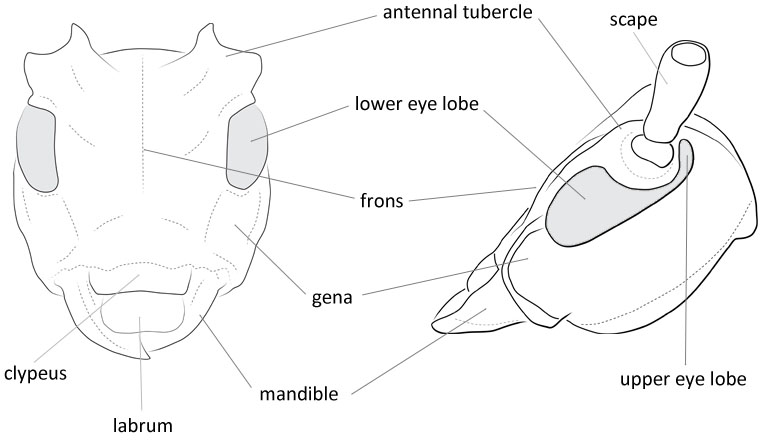Body length: 6–11 mm.
Eyes: eye interommatidial setaeseta:
a sclerotized hair-like projection of the cuticle
absent, eye deeply emarginateemarginate:
notched at the margin > half width, eye ommatidial density fine.
> half width, eye ommatidial density fine.
Antennaeantenna:
in larval and adult insects, paired segmented appendages, borne one on each side of the head, functioning as sense organs and bearing a large number of sensilla
: antennal length reaching/surpassing end of body, antennal flagellar segments elongateelongate:
much longer than wide
, scapescape:
the first proximal segment of the antenna smooth/punctate at apexapex:
smooth/punctate at apexapex:
end of any structure distad to the base
, antennal segment 3 > scapescape:
the first proximal segment of the antenna .
.
Pronotumpronotum:
the upper and dorsal part of the prothorax
: pronotumpronotum:
the upper and dorsal part of the prothorax
shape transversetransverse:
broader than long
, pronotumpronotum:
the upper and dorsal part of the prothorax
lateral armature absent.
Prosternum: prosternal processprosternal process:
a posterior extension of the prosternum between the coxae dilated at apexapex:
dilated at apexapex:
end of any structure distad to the base
, procoxal cavities closed posteriorly.
Elytraelytron:
the leathery forewing of beetles, serving as a covering for the hind wings, commonly meeting opposite elytron in a straight line down the middle of the dorsum in repose
: elytral length reaching or close to end of abdomen, elytral apicesapex:
end of any structure distad to the base
rounded or truncatetruncate:
cut off squarely at the tip
, elytral color pattern present.
Legs: visible tarsomerestarsomere:
subdivision or article of the tarsus, usually numbering from two to five : 4, femora clavateclavate:
: 4, femora clavateclavate:
thickening gradually toward the tip
, protibial spursprotibial spur:
sclerotized spine(s) located at the distal tibia; can be single, double, or absent : 2, tarsal clawstarsal claw:
: 2, tarsal clawstarsal claw:
usually paired claws of the pretarsus, at the distal end of the leg simple.
simple.
Antennaeantenna:
in larval and adult insects, paired segmented appendages, borne one on each side of the head, functioning as sense organs and bearing a large number of sensilla
fine, slightly fringed underneath; the first segment a little long, thinned towards the apexapex:
end of any structure distad to the base
, arched dorsally, the third segment somewhat longer than the fourth, much longer than the first. Antennal tubercles moderately protruding. Eyes finely faceted, strongly emarginateemarginate:
notched at the margin , the lower lobes across. Pronotumpronotum:
, the lower lobes across. Pronotumpronotum:
the upper and dorsal part of the prothorax
short, transversetransverse:
broader than long
, arched, rounded at the sides, with two fine transversetransverse:
broader than long
furrows, a front and a rear. Elytraelytron:
the leathery forewing of beetles, serving as a covering for the hind wings, commonly meeting opposite elytron in a straight line down the middle of the dorsum in repose
long, arched, apically rounded. Retractable head. Prosternal processprosternal process:
a posterior extension of the prosternum between the coxae very narrow, much lower than the coxae, rounded. Mesosternal processmesosternal process:
very narrow, much lower than the coxae, rounded. Mesosternal processmesosternal process:
a prolongation of the mesosternum extending between the mesocoxae
towards the anterior margin gradually inclined. Metasternum of normal length. Legs moderately long, femora slightly clavateclavate:
thickening gradually toward the tip
, the fourth tarsomeretarsomere:
subdivision or article of the tarsus, usually numbering from two to five long and thin (adapted from Breuning 1963aBreuning 1963a:
long and thin (adapted from Breuning 1963aBreuning 1963a:
Breuning S. 1963a. Bestimmungstabelle der Lamiiden-Triben nebst Revision der Pteropliini der asiatischen Region (Col. Cerambycidae) II. Teil. Entomologische Arbeiten aus dem Museum G. Frey, Tutzing bei München 14 (1): 168–251, figs 3–8.).
Prosoplus, Pterolophia (Pterolophia)
Mesosella has no lateral tubercles on the pronotumpronotum:
the upper and dorsal part of the prothorax
and has more than one row of facets connecting the lobes of the eye.
Japan
broadleaf; Pinaceae
2 spp. Conifers: M. simiola.
Mesosella Bates, 1884